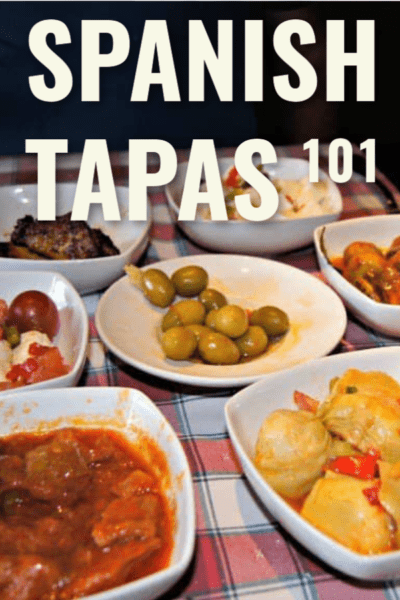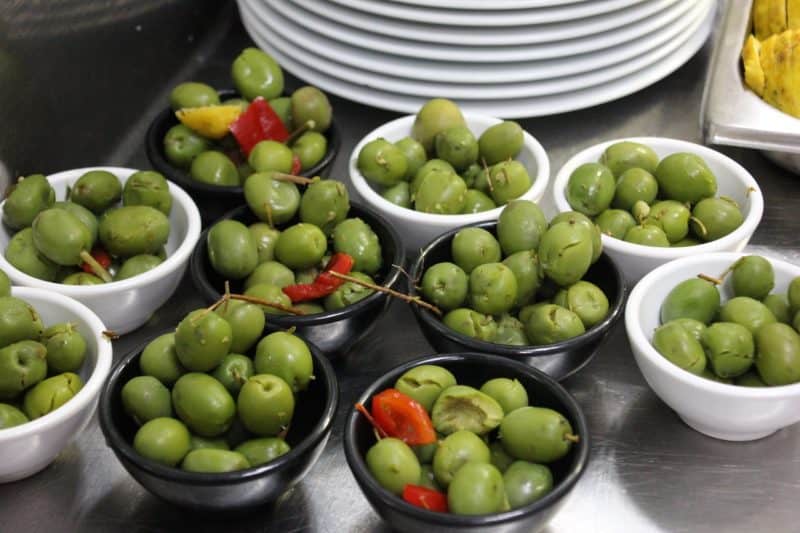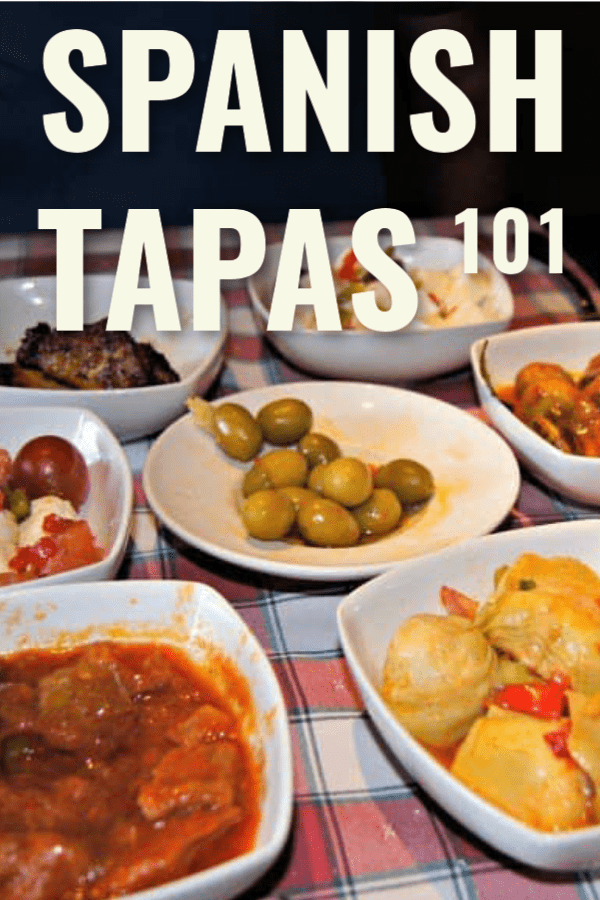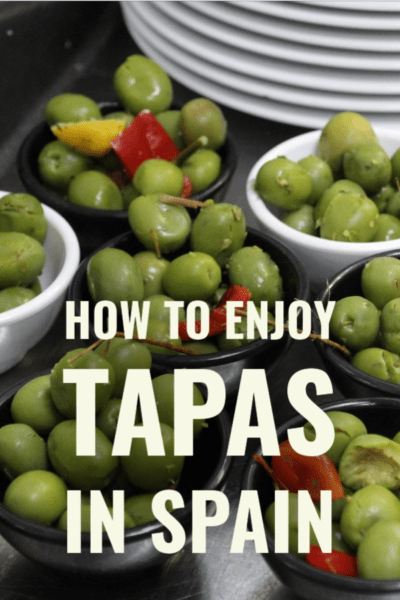Lessons in culture may come at the most unexpected times, but they can be super fun nonetheless. One of our favorites came during a long layover in Madrid.
Just as we’d planned, within an hour of touching down, we were experiencing the tapas culture in Spain, right along with the locals.
Let us tell you what we discovered.

Why are tapas popular in Spain?
Tapas are popular in Spain for a number of reasons:
- It’s a long time between lunch and dinner, so Spaniards cover their hunger at tapas bars.
- Tapas are economical, because most local bars serve a free tapa along with the first drink.
- They’re perfect for sharing with friends and inspire conversation as locals go from bar to bar.
- Tapas let you sample different dishes from a restaurant’s menu without having to commit to just one entree.
Spain is renowned for its vibrant food scene, and tapas culture is a big part of that. So next time you’re in Spain, make sure to order some tapas and enjoy the ride!
Where did tapas originate?
Although most accounts claim that the tradition came from Andalucía, the origin of tapas is debated. Because the Spanish word tapa means lid, cover, or top, one theory says that people once used bread or a small plate of olives or ham to keep dust and insects out of a drink.
Others credit King Alfonso X (1221-1284) with popularizing tapas in Spain. When his doctor prescribed large amounts of wine to treat an illness, the king ate small portions of food alongside his drink to diminish the effects of the alcohol. After regaining his health, he decreed that all drinks should be served with something to eat.
What exactly are tapas?

In Spain, tapas are basically bar snacks, small plates of bite-size food that are served along with your drink.
While a few tapas traditions differ throughout Spain (you can enjoy it from Barcelona to Andalucia), one thing remains the same: Tapas culture revolves around the experience of sharing small bites with friends.

But your tapa is only free with the first glass. Also, it’s only one per table, which means that you’ll have to share your tapa with your table mates. And trust us: A bowl of olives doesn’t go very far.
If your appetite is screaming for attention or the waiter brought you a tapa that was so delicious that you want a second order, you can order a pincho or a racion instead.
There are a few key differences between tapas, pintxos and raciones. First, tapas are typically bite-size dishes served on a plate, while pintxos are are often served on bread, with skewers or toothpicks. Raciones, on the other hand, are larger portions that can be shared as either an appetizer or main course.
But there’s also a better option.
Bar hopping is big in tapas culture
Spanish culture includes a lot of bar hopping in the early evening. They even have a verb for it: tapear. After all, they’ll get a free tapa with the first drink, so they’ve got it figured out. Locals generally only order one glass of wine per bar, then settle their tabs and head to the next.
Even though liquor and mixed drinks are readily available, the cervezas and local wines are so inexpensive (and delicious) that I don’t recall ever seeing anything else on the table. That said, our go-to drink was a Spanish wine cocktail called tinto de verano.
ⓘ TIP: Patronize the bars on side streets. Yes, the ones that look like local hangouts. Rumor has it that tapas that are prepared for locals are of better quality. Besides, some bars in tourist areas have quit serving tapas. Here’s a guide to where to find cheap tapas in Madrid.
Rather than sitting at a table, people commonly eat their tapas standing up at the bar or at small tables. It stands to reason, because tapas are informal and the bars are often busy.
When you go, expect the atmosphere to be convivial and noisy.
What are some popular tapas?
I suspect that many of the popularly-served tapas are intentionally salty — things like almonds, olives or marinated beans, to a plate of cheese or meat. Good marketing move: Salt makes patrons more thirsty, thus they will want to drink more.
Popular tapas may include cheese and olives, but tapas can be almost anything. Here are a few examples:
- Espinacas con garbanzos: spinach and chick peas with olive oil and garlic
- Patatas bravas: fried potato wedges served with a spicy alioli sauce
- Tortilla: potato omelette
- Revueltos: scrambled eggs with various fillings
- Gazpacho: cold tomato soup with cucumber and garlic
- Salmorejo: a thicker version of gazpacho, often used as a sauce
- Bacalao: salted cod, which can be breaded, fried or stewed in tomato sauce
- Montaditos: small filled buns, often served toasted
And of course, a lot of Spanish cuisine revolves around pork and seafood.

What tapas can you eat if you have a food allergy?
Whether for religious or health reasons, many people have dietary limitations. Some people have issues with gluten, nuts, or seafood. We follow a Biblical diet, meaning we don’t eat scavengers like pigs and shellfish. One of us is also sensitive to grains.
These days, it’s always something.
You might think Ensaladilla would be a safe vegetarian option, but this simple potato salad with mayonnaise sometimes contains tuna or prawns. And even gazpacho contains bread.
But don’t let food sensitivities keep you from traveling … or eating tapas. We enjoyed the tapas tradition – and Spanish food in general – even though ham is ubiquitous all over, and they like their prawns as well. We always found wait staff eager to offer their advice.
ⓘ TIP: If your server is clueless about what’s hiding in a dish, it’s perfectly fine to ask him to check with the chef.
I’ve not figured out an easy way to avoid wheat or gluten. However, if you don’t do seafood or certain meats, the least complicated way is to tell the waiter that you’re a vegetarian. “Soy vegetariano/a. Que tapas no tienen carne ni pescado?” (I’m vegetarian, which tapas don’t have any meat or seafood?)
I don’t know if that always does the trick, but I do know that they never brought us anything that even slightly resembled meat or prawns when we said that.
We were thrilled whenever a waiter brought us a bowl of olives or a few pieces of cheese.
Want a food tour?
Sometimes, it’s more fun to have someone show you around. If that’s you, book a tapas walking tour while you’re in Spain.
Your guide will take you to places that are local hangouts and will point out cultural nuances that you might otherwise miss.
You’ll taste the city’s best dishes, learn the ins and outs of how to order drinks and food, experience the country’s lively and vibrant tapas culture, and meet new foodie friends.
What if you don’t speak Spanish?
Avoiding tourist areas pays off: Prices and foods are better on the side streets. But don’t worry if you don’t speak Spanish. English tourists have paved the way for you, as have the movies and public schools. So English is widely spoken in larger cities.
Feel free to use whatever Spanish you know, even if it’s only the word gracias. It may seem minor, but it enhances the travel experience. And don’t worry, because people don’t mind when visitors mangle their language. They just appreciate the effort.
In Barcelona and the surrounding area, you may overhear some people speaking a language other than Spanish. They are speaking Catalan, the regional language (there’s an independence movement in that region). If you only speak Spanish, don’t worry; they’ll understand just fine.
In Madrid, we had to adjust to the Castillian accent—they use th instead of s — but otherwise it’s not too hard to comprehend.
That is, when they speak slowly enough.
On Amazon
- Tapas: The Little Dishes of Spain
- Pintxos: Small Plates in the Basque Tradition
- The Cambridge Companion to Modern Spanish Culture
Share these tapas food and culture tips with your Faceebook friends.






If bars give a free tapa, it may seem like an implied gesture to buy more wine or beer. Spaniards are by nature generous, so the best way to appreciate this is perhaps to buy more wine and tapas!
A very interesting article, indeed.
Hey, right on with most of your observations! Yes, the tapas are salty a lot of times, to make order more beer, and yes, most of the people that go to a bar, they prefer to stand up, in some bars they don’t even have tables, however, it has nothing to do with the price, its their culture, they spend hours like standing up having their beers and chatting away.
My huspand, who is Spanish, has explained that bar is a social scene, and this way they have a perfect excuse to casually chat to someone they don’t know, and who knows, maybe even become friends. Your post shows you are an excellent and curious traveller and observer. Here is our article about the origins of tapas http://madsnailtravel.blogspot.com.es/2014/06/memories-of-guide-king-of-kings-or-how.html
Natalia
MadSnail Travel
Thanks for the information; it was an interesting article.
And thanks as well for the compliment. That’s why we’re here: to show how easy and fun it can be to get involved in a country’s culture.
We were in Madrid last November during a long layover too. Puerta del Sol is such an awesome area to hang out. Although we were traveling with kids so we never got to do some tapas bar hopping. Great insight into the world of tapas. We loved the tapas at Mercado de San Miguel.
Oh, I’d forgotten about Mercado de San Miguel. We had such a blast there – stayed in Madrid decompressing for a week and did nothing but eat, sleep, and play.
It’s a fabulous place. We discovered it quite by accident. How did you find out about it?
Spain is in my dream vacation list but can’t go there coz of busy schedule, work, work and work. Whish this year won’t be the same and get a chance to go in a vacation.
Anyways amazing article and great writing skills. Thanx for sharing your experience.
I can relate, Rana. We really want to see what Asia has to offer but can’t manage it either. I do hope you can visit Spain. We haven’t seen much more than Madrid, Barcelona and Costa Brava so far. Our friend writes a blog about living in Spain (Sunshine and Siestas) and there’s so much to enjoy there!
In the meantime, don’t forget that you can play tourist for a day … just by exploring near your home. For instance, we just found out that there are some wineries we can visit near to where we are in Florida. (Wineries in Florida? What a surprise that was!) Perhaps we will share that experience here, if people are interested.
Thank you for the kind words, that means a lot to me.
No tapas here Linda but I curiously see signs/restaurants for tapas in so many tourist areas. Interesting.
As for the layover wow do I hear you.
So pleasant to have a good and proper layover versus those 4 hour or less jobs where you’re stuck in the Layover Twilight Zone lol.
Jet lag kicks in and you can’t get to a hotel room to get situated.
We have a Bali trip in like 4 weeks; we decided to do a real layover….at least I think 😉
Happy Tapas 🙂
Ryan
Ryan, I read about your ridiculously long trip from Phuket to Fiji. Goodness – FOUR DAYS? I imagine you spent plenty of hours on ground between flights there, my friend.
So, it’s back to Bali, is it? Fabulous! For how long? Will you be returning to your old stomping grounds, or exploring a new area with a housesit? I do hope you manage to enjoy a real layover on the way, complete with hotel. Tapas optional. 😀
Linda